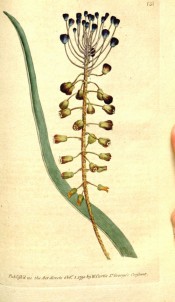Muscari comosum (L.) Mill.
Frost-hardy bulbous perennial with spreading leaves and tassels of violet flowers in spring. To 60cm. [RHSE, Hortus].
Horticultural & Botanical History
‘Most of the old Botanists arranged this plant, the racemosus, and others having almost globular flowers with the Hyacinths. Tournefort, struck with the difference in their appearance, made a distinct genus of them under the name of Muscari, in which he is followed by Miller, and should have been by Linnaeus, for they differ so much that no student would consider the present plant as belonging to the same genus with the hare-bell. This species grows wild in the corn-fields of Spain, Portugal, and some parts of Germany, and flowers in May and June. It is distinguished more by its singularity than beauty, the flowers on the summit of the stalk differing widely in colour from the others, and being mostly barren.’ [BM t.133/1790].
Paxton’s Dictionary also lists the variety monstrosum. Introduced to Britain in 1596. [JD].
History at Camden Park
Listed in all published catalogues [B.329/1843].
Notes
Published Jan 07, 2010 - 03:22 PM | Last updated Jan 07, 2010 - 03:29 PM
| Family | Hyacinthaceae |
|---|---|
| Category | |
| Region of origin | South-west Europe to Asia |
| Synonyms |
|
| Common Name | Tassel grape hyacinth, Fringe hyacinth |
| Name in the Camden Park Record |
Muscari comosum |
| Confidence level | high |


